Uncovering Nanoindention Behavior of Amorphous/Crystalline High-Entropy-Alloy Composites
Abstract
:1. Introduction
2. Simulation Method and Model
3. Result and Discussion
3.1. The Nanoindention Process
3.2. Effect of Amorphous Layer Thickness
3.3. Strengthening Model
4. Conclusions
Author Contributions
Funding
Institutional Review Board Statement
Informed Consent Statement
Data Availability Statement
Conflicts of Interest
References
- Yeh, J.W.; Chen, S.K.; Lin, S.J.; Gan, J.Y.; Chin, T.S.; Shun, T.T.; Tsau, C.H.; Chang, S.Y. Nanostructured high-entropy alloys with multiple principal elements: Novel alloy design concepts and outcomes. Adv. Eng. Mater. 2004, 6, 299–303. [Google Scholar] [CrossRef]
- Cantor, B.; Chang, I.; Knight, P.; Vincent, A. Microstructural development in equiatomic multicomponent alloys. Mater. Sci. Eng. A 2004, 375, 213–218. [Google Scholar] [CrossRef]
- George, E.P.; Curtin, W.A.; Tasan, C.C. High entropy alloys: A focused review of mechanical properties and deformation mechanisms. Acta Mater. 2020, 188, 435–474. [Google Scholar] [CrossRef]
- Chen, Y.; Feng, H.; Li, J.; Liu, B.; Jiang, C.; Liu, Y.; Fang, Q.; Liaw, P.K. Dislocation flow turbulence simultaneously enhances strength and ductility. Proc. Natl. Acad. Sci. USA 2024, 121, e2316912121. [Google Scholar] [CrossRef]
- Tian, Q.; Zhang, G.; Yin, K.; Wang, W.; Cheng, W.; Wang, Y. The strengthening effects of relatively lightweight AlCoCrFeNi high entropy alloy. Mater. Charact. 2019, 151, 302–309. [Google Scholar] [CrossRef]
- Li, J.; Chen, H.; Feng, H.; Fang, Q.; Liu, Y.; Liu, F.; Wu, H.; Liaw, P. Microstructure evolution and deformation mechanism of amorphous/crystalline high-entropy-alloy composites. J. Mater. Sci. Technol. 2020, 54, 14–19. [Google Scholar] [CrossRef]
- Qiu, Y.H.; Qi, Y.M.; Zheng, H.Y. Atomistic simulation of nanoindentation response of dual-phase nanocrystalline CoCrFeMnNi high-entropy alloy. J. Appl. Phys. 2021, 130, 125102. [Google Scholar] [CrossRef]
- Song, H.Y.; Li, Y.L. Atomic simulations of deformation mechanisms of crystalline Mg/amorphous Mg–Al nanocomposites. Phys. Lett. A. 2015, 379, 2087–2091. [Google Scholar] [CrossRef]
- Wu, G.; Chan, K.C.; Zhu, L.L.; Sun, L.G.; Lu, J. Dual-phase nanostructuring as a route to high-strength magnesium alloys. Nature 2017, 545, 80–83. [Google Scholar] [CrossRef]
- Du, J.J.; Song, H.Y.; An, M.R.; Li, Y.L. Effect of rare earth element on amorphization and deformation behavior of crystalline/amorphous dual-phase Mg alloys. Mater. Des. 2022, 221, 110979. [Google Scholar] [CrossRef]
- Dai, J.L.; Song, H.Y.; An, M.R. Atomic simulation of interaction mechanism between dislocation and amorphous phase in dual-phase crystalline/amorphous Mg/MgAl alloys. J. Appl. Phys. 2020, 127, 135105. [Google Scholar] [CrossRef]
- Xiao, L.L.; Zheng, Z.Q.; Guo, S.W.; Huang, P.; Wang, F. Ultra-strong nanostructured CrMnFeCoNi high entropy alloys. Mater. Des. 2020, 194, 108895. [Google Scholar] [CrossRef]
- Wu, G.; Balachandran, S.; Ganlt, B.; Xia, W.; Liu, C.; Rao, Z.; Wei, Y.; Liu, S.; Lu, J. Crystal–glass high-entropy nanocomposites with near theoretical compressive strength and large deformability. Adv. Mater. 2020, 32, 2002619. [Google Scholar] [CrossRef]
- Han, R.C.; Song, H.Y.; Han, L.; An, M.R. Atomistic insights on the deformation mechanisms of amorphous/crystalline dual-phase high entropy alloys under nanoindentation. J. Mater. Res. Technol. 2023, 25, 6027–6038. [Google Scholar] [CrossRef]
- Wang, Y.; Li, J.; Hamza, A.V.; Barbee, T.W. Ductile crystalline–amorphous nanolaminates. Proc. Natl. Acad. Sci. USA 2007, 104, 11155–11160. [Google Scholar] [CrossRef]
- Arman, B.; Brandl, C.; Luo, S.N. Plasticity in Cu (111)/Cu46Zr54 glass nanolaminates under uniaxial compression. J. Appl. Phys. 2011, 110, 043539. [Google Scholar] [CrossRef]
- Wang, F.; Wu, H.; Dong, L.; Pan, G.; Zhou, X.; Wang, S.; Guo, R.; Wu, G.; Gao, J.; Dai, F.; et al. Atomic-scale simulations in multi-component alloys and compounds: A review on advances in interatomic potential. J. Mater. Sci. Technol. 2023, 165, 49–65. [Google Scholar] [CrossRef]
- Ma, Y.; Yang, M.; Yuan, F.; Wu, X. Deformation induced hcp nano-lamella and its size effect on the strengthening in a CoCrNi medium-entropy alloy. J. Mater. Sci. Technol. 2021, 82, 122–134. [Google Scholar] [CrossRef]
- Meng, Z.C.; Yang, M.M.; Feng, A.H.; Qu, S.J.; Zhao, F.; Yang, L.; Yao, J.H.; Yang, Y.; Fan, Q.B.; Wang, H. Transfer or blockage: Unraveling the interaction between deformation twinning and grain boundary in tantalum under shock loading with molecular dynamics. J. Mater. Sci. Technol. 2023, 156, 118–128. [Google Scholar] [CrossRef]
- Han, R.C.; Song, H.Y.; Li, S.; Guo, T. Atomistic simulation of nanoindentation behavior of amorphous/crystalline dual-phase high entropy alloys. J. Mater. Sci. Technol. 2024, 197, 46–56. [Google Scholar] [CrossRef]
- Song, H.Y.; Zhang, K.; An, M.R.; Wang, L.; Xiao, M.X.; Li, Y.L. Atomic simulation of interaction mechanism between basal/prismatic interface and amorphous/crystalline interface of dual-phase magnesium alloys. J. Non-Cryst. Solids 2019, 521, 119550. [Google Scholar] [CrossRef]
- Li, J.; Chen, H.; Li, S.; Fang, Q.H.; Liu, Y.; Liang, L.; Wu, H.; Liaw, P.K. Tuning the mechanical behavior of high-entropy alloys via controlling cooling rates. Mater. Sci. Eng. A 2019, 760, 359–365. [Google Scholar] [CrossRef]
- Hua, D.; Wang, W.; Luo, D.; Zhou, Q.; Li, S.; Shi, J.; Fu, M.; Wang, H. Molecular dynamics simulation of the tribological performance of amorphous/amorphous nano-laminates. J. Mater. Sci. Technol. 2022, 105, 226–236. [Google Scholar] [CrossRef]
- Hua, D.; Ye, W.; Jia, Q.; Zhou, Q.; Xia, Q.; Shi, J.; Deng, Y.; Wang, H. Molecular dynamics simulation of nanoindentation on amorphous/amorphous nanolaminates. Appl. Surf. Sci. 2020, 511, 145545. [Google Scholar] [CrossRef]
- Doan, D.Q. Interfacial characteristics and their impact on the indentation behavior of CuTa/CuTa amorphous/amorphous nanolaminates. Int. J. Mech. Sci. 2022, 223, 107297. [Google Scholar] [CrossRef]
- Chen, Y.; Reng, S.W.; Peng, J.; Liu, X.B. Chemical short range order and deformation mechanism of a refractory high entropy alloy HfNbTaZr under nanoindentation: An atomistic study. J. Mater. Res. Technol. 2023, 24, 3588–3598. [Google Scholar] [CrossRef]
- Daw, M.S.; Baskes, M.I. Embedded-atom method: Derivation and application to impurities, surfaces, and other defects in metals. Phys. Rev. B 1984, 29, 6443. [Google Scholar] [CrossRef]
- Lu, C.; Niu, L.; Chen, N.; Jin, K.; Yang, T.; Xiu, P.; He, M.R. Enhancing radiation tolerance by controlling defect mobility and migration pathways in multicomponent single-phase alloys. Nat. Commun. 2016, 7, 13564. [Google Scholar] [CrossRef]
- Li, J.; Fang, Q.H.; Liu, B.; Liu, Y.; Liu, Y.W. Mechanical behaviors of AlCrFeCuNi high-entropy alloys under uniaxial tension via molecular dynamics simulation. RSC Adv. 2016, 6, 76409–76419. [Google Scholar] [CrossRef]
- Li, J.; Fang, Q.; Liu, B.; Liu, Y. Transformation induced softening and plasticity in high entropy alloys. Acta Mater. 2019, 147, 35–41. [Google Scholar] [CrossRef]
- Afkham, Y.; Bahramyan, M.; Mousavian, R.T.; Brabazon, D. Tensile properties of AlCrCoFeCuNi glassy alloys: A molecular dynamics simulation study. Mater. Sci. Eng. A 2017, 698, 143–151. [Google Scholar] [CrossRef]
- Fang, Q.; Yi, M.; Li, J.; Liu, B.; Huang, Z. Deformation behaviors of Cu29Zr32Ti15Al5Ni19 high entropy bulk metallic glass during nanoindentation. Appl. Surf. Sci. 2018, 443, 122–130. [Google Scholar] [CrossRef]
- Plimpton, S. Fast parallel algorithms for short-range molecular dynamics. J. Comput. Phys. 1995, 117, 1–19. [Google Scholar] [CrossRef]
- Stukowski, A. Visualization and analysis of atomistic simulation data with OVITO the Open Visualization Tool. Model. Simulat. Mater. Sci. Eng. 2010, 18, 015012. [Google Scholar] [CrossRef]
- Yin, Y.Z.; Lu, Y.; Zhang, T.P.; Han, W.Z. Nanoindentation avalanches and dislocation structures in HfNbTiZr high entropy alloy. Scr. Mater. 2023, 227, 115312. [Google Scholar] [CrossRef]
- Dhal, A.; Haridas, R.S.; Agrawal, P.; Gupta, S.; Mishra, R.S. Mapping hierarchical and heterogeneous micromechanics of a transformative high entropy alloy by nanoindentation and machine learning augmented clustering. Mater. Des. 2023, 230, 111957. [Google Scholar] [CrossRef]
- Nguyen, H.G.; Fang, T.H. Plastic deformation in nanoindentation of Alx(CuCrFeNi)1−x high entropy alloy. J. Alloys Compd. 2023, 968, 172172. [Google Scholar] [CrossRef]
- Han, X.; Liu, P.; Sun, D.; Wang, Q. The role of incoherent interface in evading strength-ductility trade-off dilemma of Ti2AlN/TiAl composite: A combined in-situ TEM and atomistic simulations. Compos. Part B Eng. 2020, 185, 107794. [Google Scholar] [CrossRef]
- Du, Y.; Hua, D.; Zhou, Q.; Pei, X.; Wang, H.; Ren, Y.; Wang, H.; Liu, W. Concurrently achieving strength-ductility combination and robust anti-wear performance in an in-situ high-entropy bulk metallic glass composite. Compos. Part B Eng. 2024, 272, 111222. [Google Scholar] [CrossRef]
- Xu, Q.; Şopu, D.; Yuan, X.; Kiener, D.; Eckert, J. Interface-related deformation phenomena in metallic glass/high entropy nanolaminates. Acta Mater. 2022, 237, 118191. [Google Scholar] [CrossRef]
- Cui, Y.N.; Peng, C.X.; Cheng, Y.; Wang, Y.Y.; Wang, L.; Zhou, S.X. Deformation mechanism of amorphous/crystalline phase-separated alloys: A molecular dynamics study. J. Non-Cryst. Solids 2019, 523, 119605. [Google Scholar] [CrossRef]
- Zhang, L.; Sun, J.; Fan, H.; Ning, Z.; Huang, Y. Effect of crystalline phase on deformation behaviors of amorphous matrix in a metallic glass composite. Mater. Sci. Eng. A 2023, 872, 144957. [Google Scholar] [CrossRef]
- Lassnig, A.; Zak, S. Precise determination of Young’s modulus of amorphous CuZr/nanocrystalline Cu multilayer via nanoindentation. J. Mater. Res. 2023, 38, 3324–3335. [Google Scholar] [CrossRef] [PubMed]
- Qian, L.; Yang, W.; Luo, J.; Wang, Y.; Chan, K.C.; Yang, X.S. Amorphous Thickness-Dependent Strengthening–Softening Transition in Crystalline–Amorphous Nanocomposites. Nano Lett. 2023, 23, 11288–11296. [Google Scholar] [CrossRef] [PubMed]
- Tian, L.; Wang, X.L.; Shan, Z.W. Mechanical behavior of micronanoscaled metallic glasses. Mater. Res. Lett. 2016, 4, 63–74. [Google Scholar] [CrossRef]
- Wang, Z.; Fang, Q.; Li, J.; Liu, B.; Liu, Y. Effect of lattice distortion on solid solution strengthening of BCC high-entropy alloys. J. Mater. Sci. Technol. 2018, 34, 349–354. [Google Scholar] [CrossRef]
- Toda-Caraballo, I.; Rivera-Díaz-del-Castillo, P.E. Modelling solid solution hardening in high entropy alloys. Acta Mater. 2015, 85, 14–23. [Google Scholar] [CrossRef]
- Senkov, O.N.; Wilks, G.B.; Miracle, D.B.; Chuang, C.P.; Liaw, P.K. Refractory high-entropy alloys. Intermetallics 2010, 18, 1758–1765. [Google Scholar] [CrossRef]
- Zhao, Y.; Zhang, J.; Wang, Y.; Wu, S.; Liang, X.; Wu, K.; Sun, J. The metastable constituent effects on size-dependent deformation behavior of nanolaminated micropillars: Cu/FeCoCrNi vs Cu/CuZr. J. Mater. Sci. Technol. 2021, 68, 16–29. [Google Scholar] [CrossRef]
- Peng, J.; Cui, S.; Tian, Y.; Fang, Q.; Li, J.; Liaw, P.K. Effects of grain boundary on irradiation-induced zero-dimensional defects in an irradiated copper. Appl. Math. Mech. 2022, 43, 233–246. [Google Scholar] [CrossRef]
- Fang, Q.; Peng, J.; Chen, Y.; Li, L.; Feng, H.; Li, J.; Jiang, C.; Liaw, P.K. Hardening behaviour in the irradiated high entropy alloy. Mech. Mater. 2021, 155, 103744. [Google Scholar] [CrossRef]
- Cui, Y.; Huang, P.; Wang, F.; Lu, T.J.; Xu, K.W. The hardness and related deformation mechanisms in nanoscale crystalline–amorphous multilayers. Thin Solid Film. 2015, 584, 270–276. [Google Scholar] [CrossRef]
- Li, J.; Chen, Y.; He, Q.; Xu, X.; Wang, H.; Jiang, C.; Liu, C.T. Heterogeneous lattice strain strengthening in severely distorted crystalline solids. Proc. Natl. Acad. Sci. USA 2022, 19, e2200607119. [Google Scholar] [CrossRef] [PubMed]
- Gludovatz, B.; Hohenwarter, A.; Catoor, D.; Chang, E.H.; George, E.P.; Ritchie, R.O. A fracture-resistant high-entropy alloy for cryogenic applications. Science 2014, 345, 1153–1158. [Google Scholar] [CrossRef] [PubMed]
 Fe,
Fe,  Co,
Co,  Cr, and
Cr, and  Ni. (a) The atoms are colored by the atom types. (b) The atoms are represented by different colors based on the structure types.
Ni. (a) The atoms are colored by the atom types. (b) The atoms are represented by different colors based on the structure types.
 Fe,
Fe,  Co,
Co,  Cr, and
Cr, and  Ni. (a) The atoms are colored by the atom types. (b) The atoms are represented by different colors based on the structure types.
Ni. (a) The atoms are colored by the atom types. (b) The atoms are represented by different colors based on the structure types.

 FCC structure,
FCC structure,  dislocation core structure, and
dislocation core structure, and  BCC structure. The shear strain distribution of the interface at the indentation depth: (e) 1 nm, and (f) 2 nm.
BCC structure. The shear strain distribution of the interface at the indentation depth: (e) 1 nm, and (f) 2 nm.
 FCC structure,
FCC structure,  dislocation core structure, and
dislocation core structure, and  BCC structure. The shear strain distribution of the interface at the indentation depth: (e) 1 nm, and (f) 2 nm.
BCC structure. The shear strain distribution of the interface at the indentation depth: (e) 1 nm, and (f) 2 nm.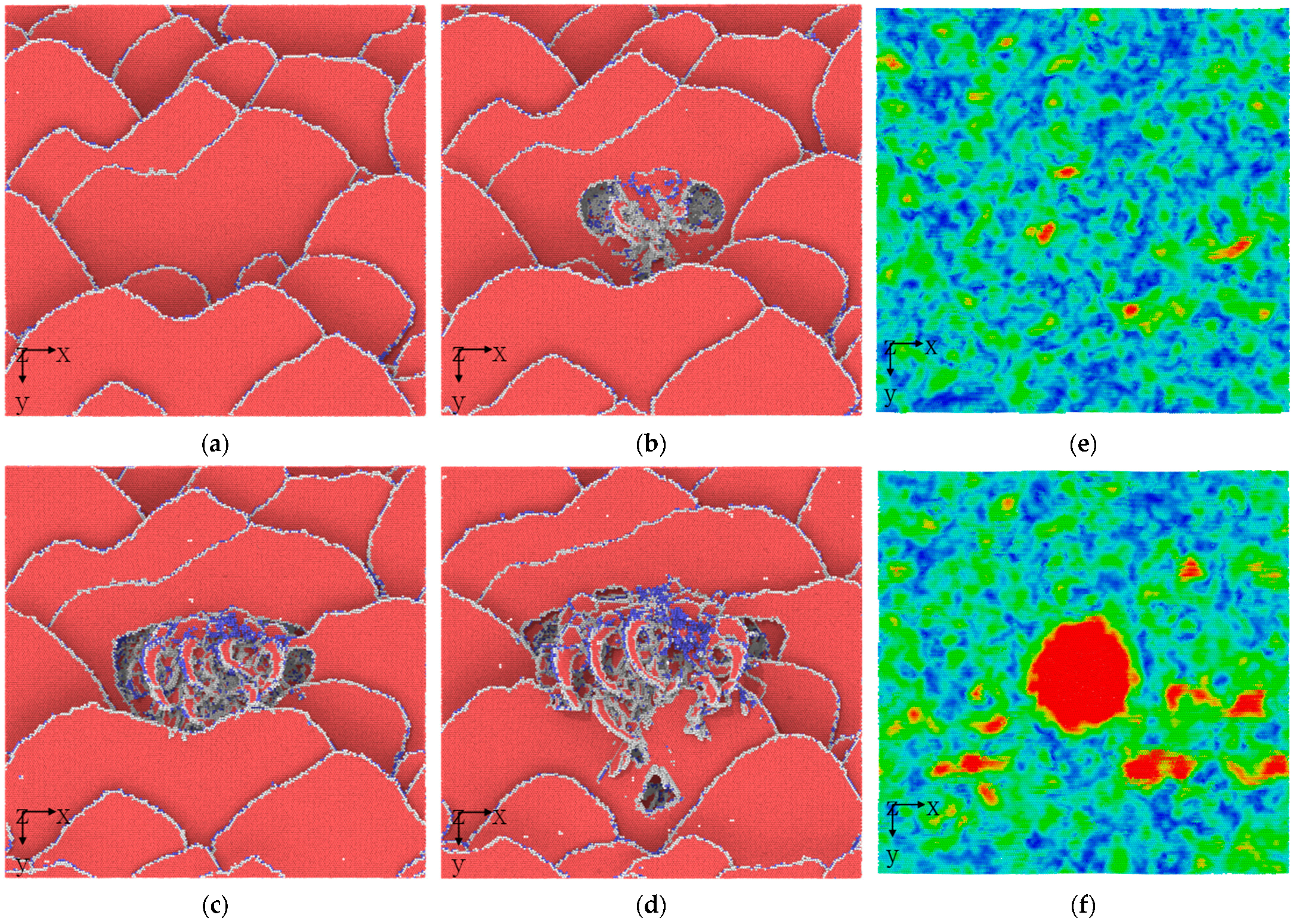

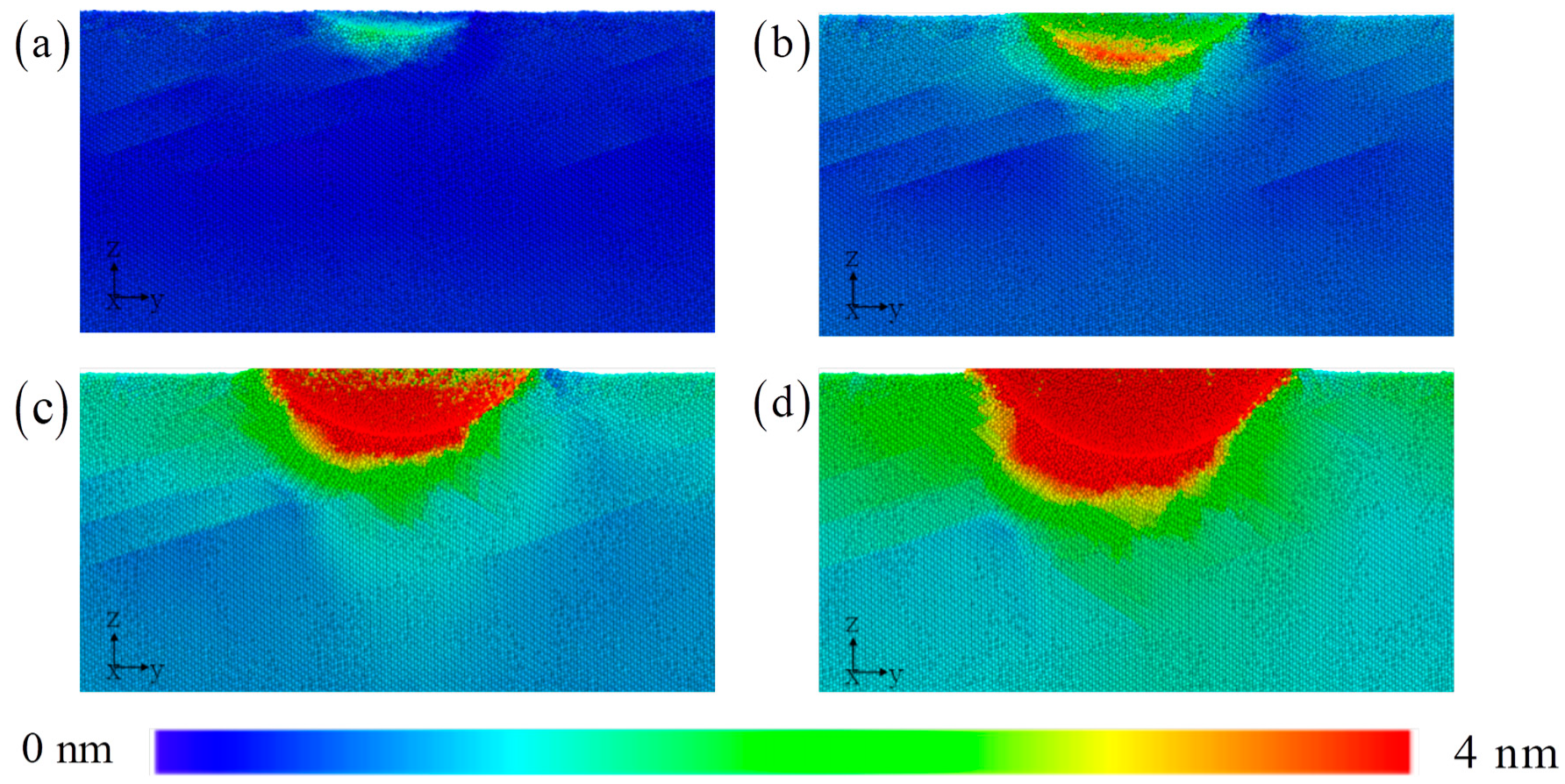
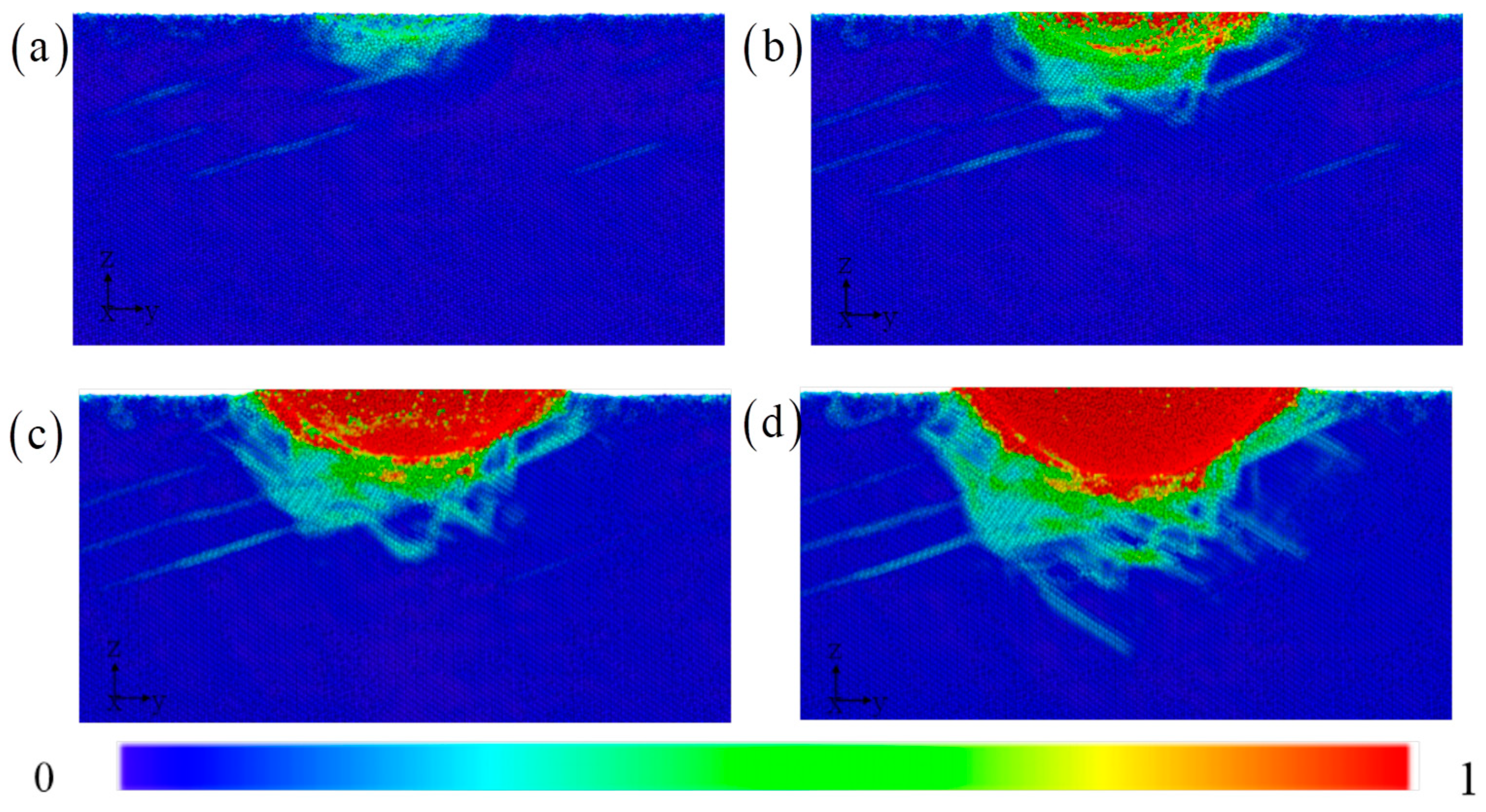

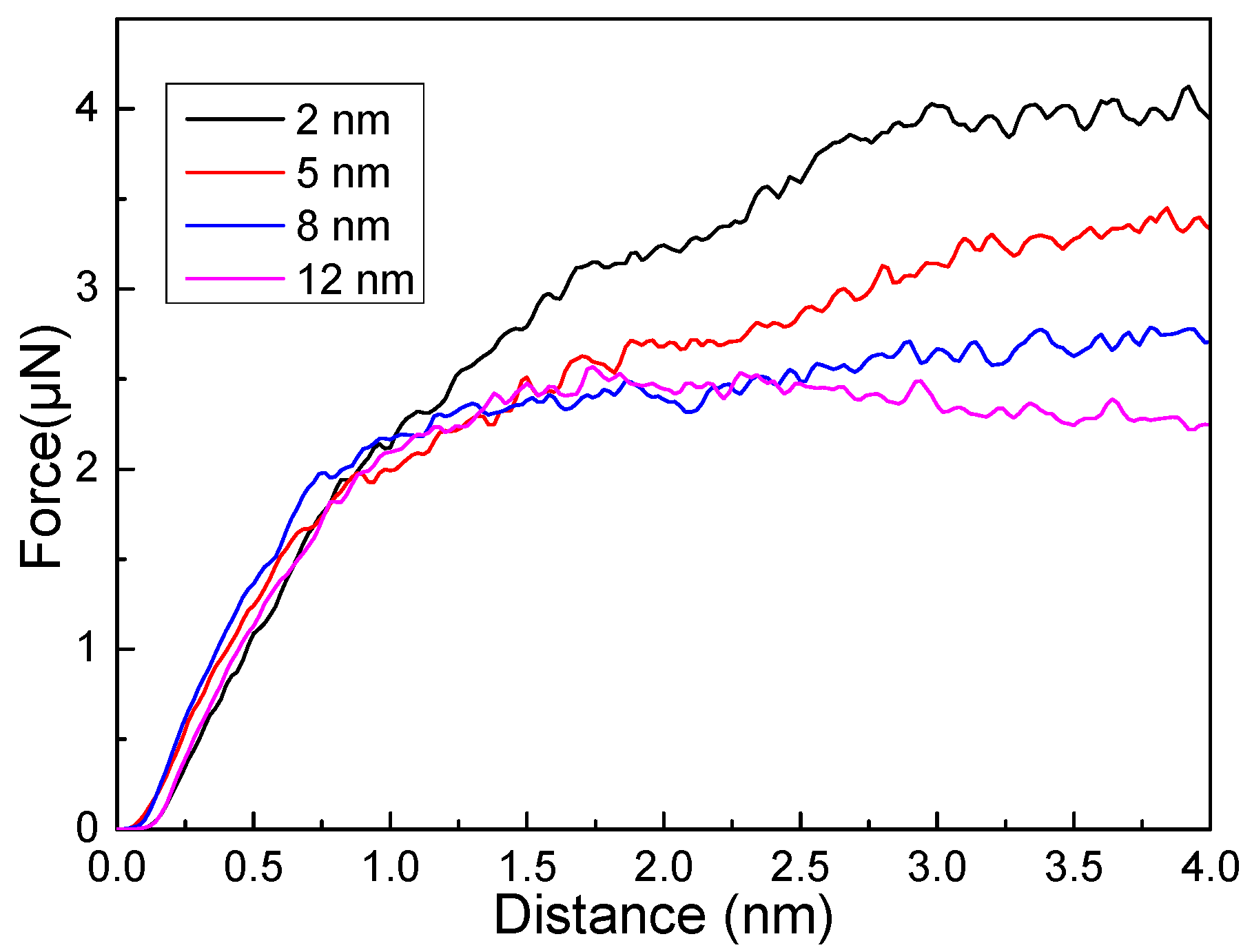


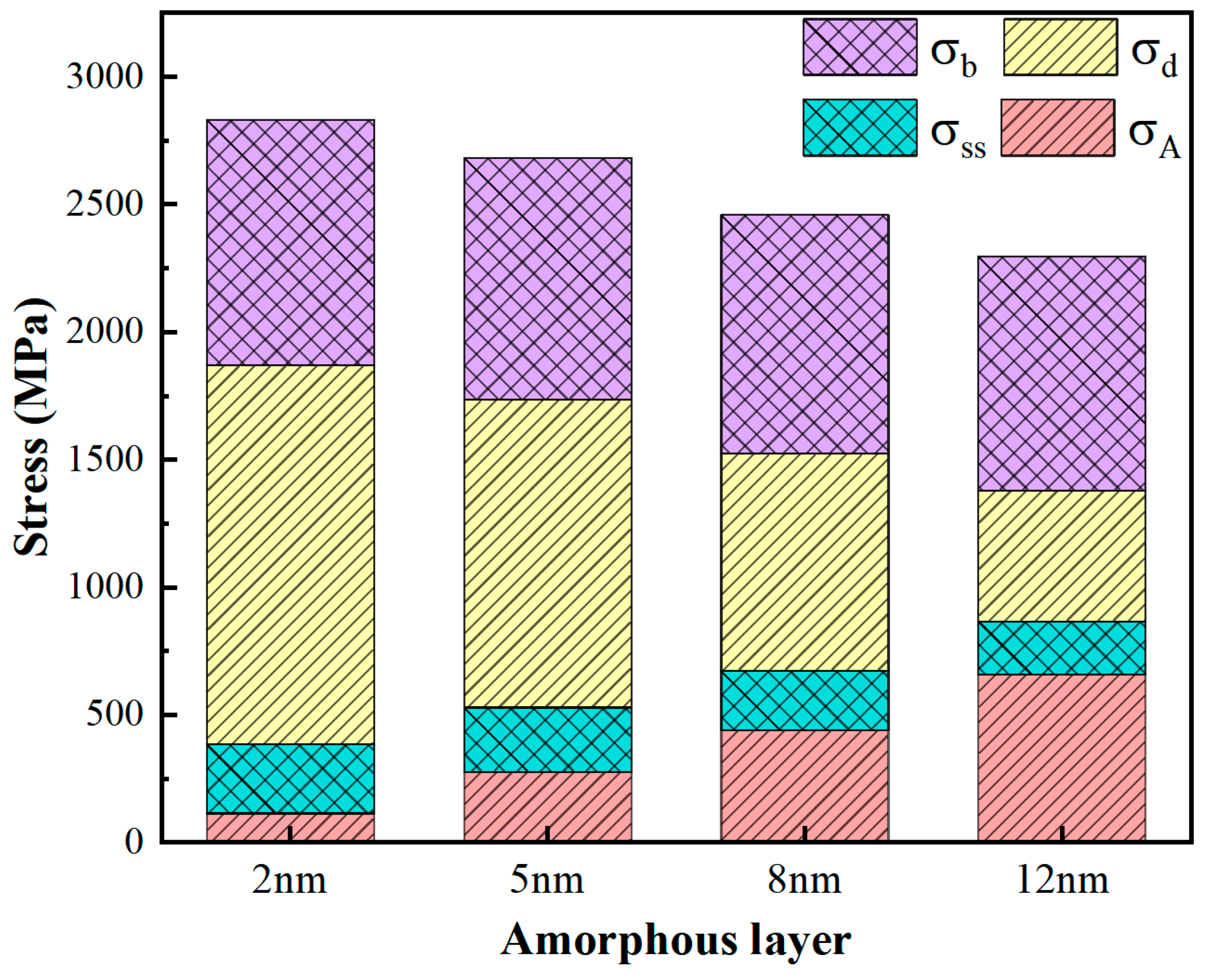
| Materials | Amorphous/Crystalline HEA Composite | Virtual Indenter |
|---|---|---|
| Dimensions | 464 Å × 455 Å × 460 Å | Radius 100 Å |
| Number of atoms | 5,595,219 | |
| Time step | 1 fs | |
| Initial temperature | 300 K | |
| Indentation velocity | 10 m/s | |
| Depth of indentation | 40 Å | |
| Thickness of amorphous layer 2 nm, 5 nm, 8 nm, and 12 nm | ||
| Parameter | Fe | Co | Cr | Ni |
|---|---|---|---|---|
| Atomic radius (pm) | 124 | 126 | 125 | 125 |
| Young’s modulus (GPa) | 211 | 209 | 279 | 200 |
| Shear modulus (GPa) | 82 | 75 | 115 | 76 |
| Atomic fraction (at%) | 25% | 25% | 25% | 25% |
| Parameter | Symbol | Magnitude |
|---|---|---|
| Taylor constant | M | 3 |
| Shear modulus (GPa) | 87 | |
| Poisson’s ratio | 0.3 | |
| Burger vector of partial dislocation (nm) | bp | 0.1476 |
| Burger vector of full dislocation (nm) | b | 0.256 |
| Thickness of amorphous (nm) | 2, 5, 8, 12 | |
| Thickness of crystalline phase (nm) | d | 44, 41, 38, 34 |
| Average density of dislocation (m−2) | 5 × 1015~1 × 1015 | |
| Empirical constant | 0.33 | |
| Empirical constant | 1.15 |
| Amorphous Layers Thickness (nm) | (MPa) | (MPa) | (MPa) | (MPa) |
|---|---|---|---|---|
| 2 | 270 | 962 | 1485 | 113.5 |
| 5 | 252 | 949 | 1206 | 276 |
| 8 | 233 | 936 | 851 | 439 |
| 12 | 209 | 917 | 513 | 657 |
Disclaimer/Publisher’s Note: The statements, opinions and data contained in all publications are solely those of the individual author(s) and contributor(s) and not of MDPI and/or the editor(s). MDPI and/or the editor(s) disclaim responsibility for any injury to people or property resulting from any ideas, methods, instructions or products referred to in the content. |
© 2024 by the authors. Licensee MDPI, Basel, Switzerland. This article is an open access article distributed under the terms and conditions of the Creative Commons Attribution (CC BY) license (https://creativecommons.org/licenses/by/4.0/).
Share and Cite
Chen, Y.; Ren, S.; Liu, X.; Peng, J.; Liaw, P.K. Uncovering Nanoindention Behavior of Amorphous/Crystalline High-Entropy-Alloy Composites. Materials 2024, 17, 3689. https://doi.org/10.3390/ma17153689
Chen Y, Ren S, Liu X, Peng J, Liaw PK. Uncovering Nanoindention Behavior of Amorphous/Crystalline High-Entropy-Alloy Composites. Materials. 2024; 17(15):3689. https://doi.org/10.3390/ma17153689
Chicago/Turabian StyleChen, Yuan, Siwei Ren, Xiubo Liu, Jing Peng, and Peter K. Liaw. 2024. "Uncovering Nanoindention Behavior of Amorphous/Crystalline High-Entropy-Alloy Composites" Materials 17, no. 15: 3689. https://doi.org/10.3390/ma17153689






